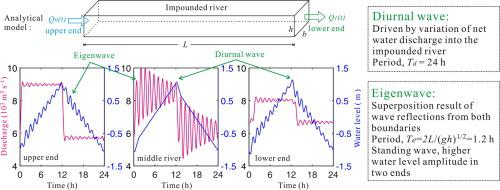当前位置:
X-MOL 学术
›
J. Hydrol.
›
论文详情
Our official English website, www.x-mol.net, welcomes your feedback! (Note: you will need to create a separate account there.)
Discharge and water level fluctuations in response to flow regulation in impounded rivers: An analytical study
Journal of Hydrology ( IF 6.4 ) Pub Date : 2020-11-01 , DOI: 10.1016/j.jhydrol.2020.125519 Zhongyong Yang , Yingying Zhu , Daobin Ji , Zhengjian Yang , Junjun Tan , Hao Hu , Andreas Lorke
Journal of Hydrology ( IF 6.4 ) Pub Date : 2020-11-01 , DOI: 10.1016/j.jhydrol.2020.125519 Zhongyong Yang , Yingying Zhu , Daobin Ji , Zhengjian Yang , Junjun Tan , Hao Hu , Andreas Lorke

|
Abstract To analyze the hydrodynamics in an impounded river in response to discharge regulation at upstream and downstream dams, we developed a one-dimensional analytical model. The model provides analytical solutions for discharge and water level fluctuations along the river for periodic discharge boundary conditions at both dams. As a case study, the model was applied to a 38 km long section of the Yangtze River located between the Three Gorges Dam and Gezhouba Dam. The outflow discharge at both dams fluctuated diurnally due to varying demand of hydropower electricity during day and night. In good agreement with observational data, the model results showed significant diurnal variation of water level and discharge along the river. Using the model, we analyzed the sensitivity of the amplitude of diurnal fluctuation of water level and discharge to the parameters describing diurnal discharge regulation. Rapid discharge changes at the dams induced large amplitudes of diurnal variation of water level and discharge in the river. The amplitude of the diurnal wave in the river depends strongly on the lag time between discharge changes at both dams and was lowest if the lag time corresponded to the propagation time of a gravity wave along the river (0.6 h in the case study). In addition to the diurnal wave, high frequency waves were generated, with a period corresponding to the eigenperiod of the impounded river system (1.2 h in our case study). The standing wave is generated by rapid discharge changes at both dams and its amplitude is strongly dependent on the lag time between these changes. The high frequency eigenwave has little influence on water level variation but relative strong influence on discharge variation in the river.
中文翻译:

蓄水河流流量调节引起的流量和水位波动:一项分析研究
摘要 为了分析蓄水河流响应上下游大坝流量调节的水动力,我们开发了一个一维分析模型。该模型为两个大坝的周期性排放边界条件提供了沿河流的排放和水位波动的解析解。作为案例研究,该模型应用于位于三峡大坝和葛洲坝大坝之间的 38 公里长的长江段。由于昼夜水电用电需求不同,两座大坝的出流流量均呈昼夜波动。模型结果与观测数据吻合较好,沿河水位和流量日变化显着。使用模型,我们分析了水位和流量的日波动幅度对描述日流量调节的参数的敏感性。大坝的快速流量变化导致河流水位和流量的日变化幅度较大。河流中昼夜波浪的幅度在很大程度上取决于两个大坝流量变化之间的滞后时间,如果滞后时间对应于重力波沿河流的传播时间(案例研究中为 0.6 小时),则该幅度最低。除了昼夜波,还产生了高频波,其周期对应于蓄水河流系统的本征周期(在我们的案例研究中为 1.2 小时)。驻波是由两个大坝的快速流量变化产生的,其振幅很大程度上取决于这些变化之间的滞后时间。
更新日期:2020-11-01
中文翻译:

蓄水河流流量调节引起的流量和水位波动:一项分析研究
摘要 为了分析蓄水河流响应上下游大坝流量调节的水动力,我们开发了一个一维分析模型。该模型为两个大坝的周期性排放边界条件提供了沿河流的排放和水位波动的解析解。作为案例研究,该模型应用于位于三峡大坝和葛洲坝大坝之间的 38 公里长的长江段。由于昼夜水电用电需求不同,两座大坝的出流流量均呈昼夜波动。模型结果与观测数据吻合较好,沿河水位和流量日变化显着。使用模型,我们分析了水位和流量的日波动幅度对描述日流量调节的参数的敏感性。大坝的快速流量变化导致河流水位和流量的日变化幅度较大。河流中昼夜波浪的幅度在很大程度上取决于两个大坝流量变化之间的滞后时间,如果滞后时间对应于重力波沿河流的传播时间(案例研究中为 0.6 小时),则该幅度最低。除了昼夜波,还产生了高频波,其周期对应于蓄水河流系统的本征周期(在我们的案例研究中为 1.2 小时)。驻波是由两个大坝的快速流量变化产生的,其振幅很大程度上取决于这些变化之间的滞后时间。


























 京公网安备 11010802027423号
京公网安备 11010802027423号